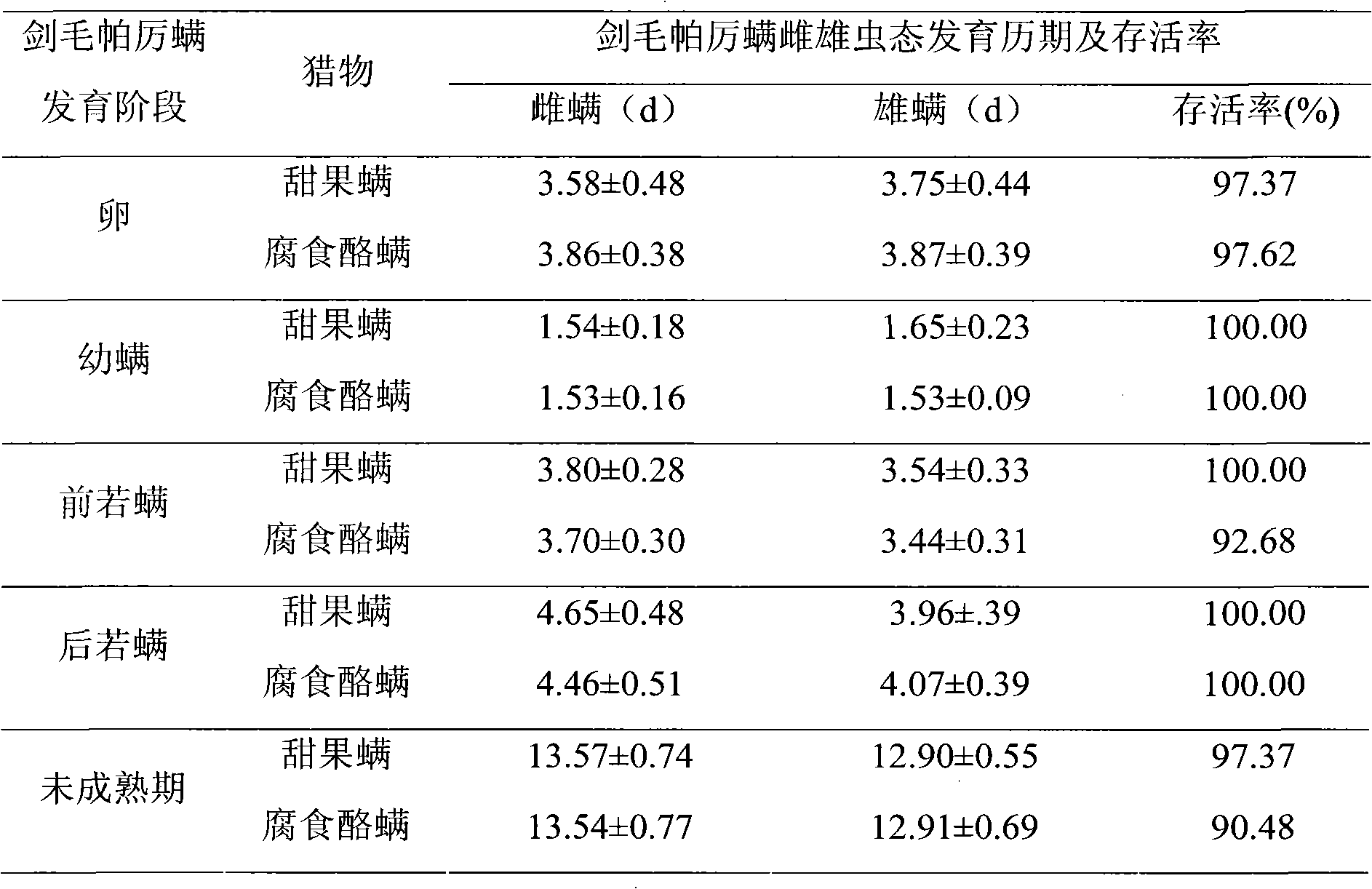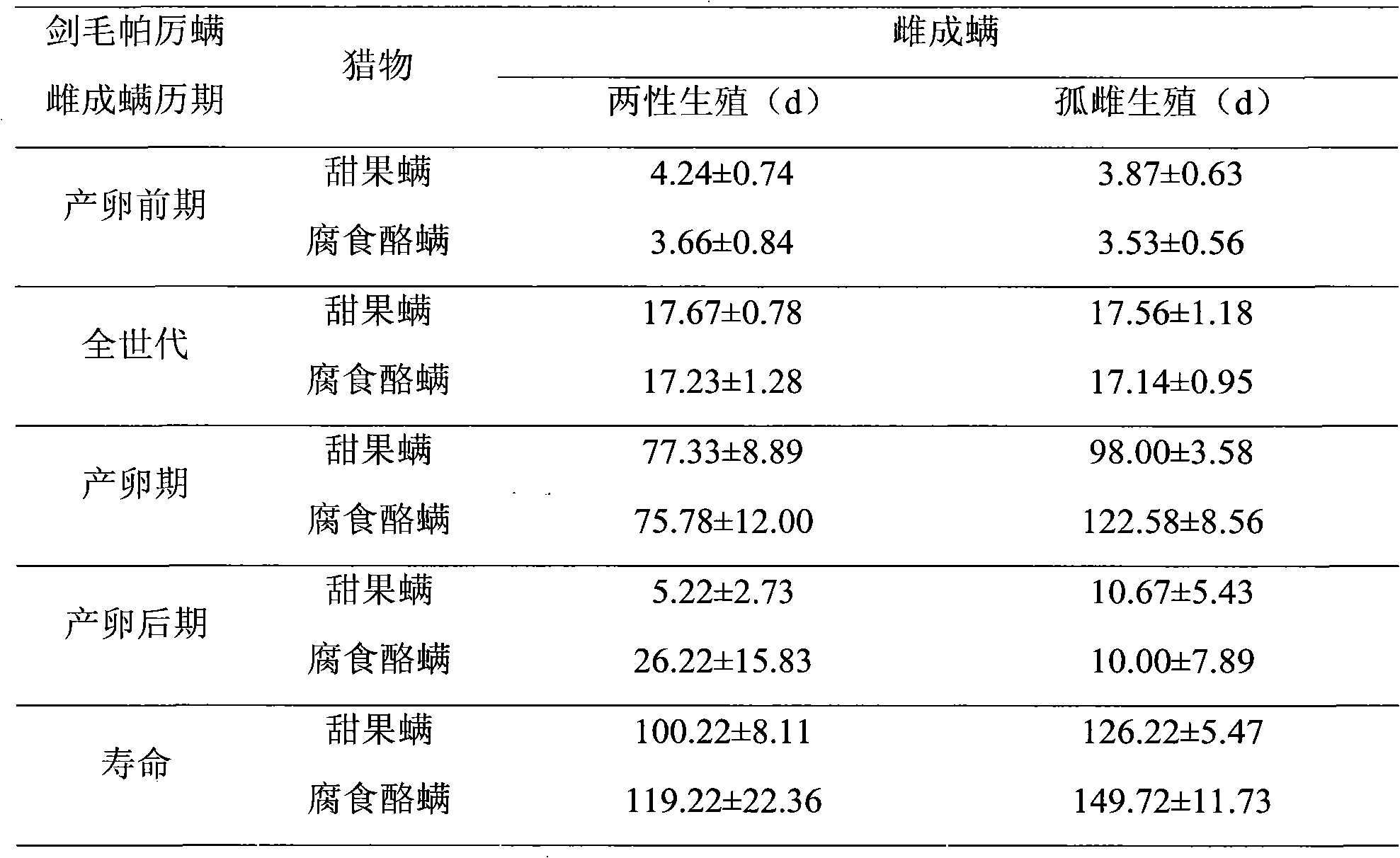Method for breeding large amount of Stratiolaelaps scimitus and Hypoaspis aculeifer (Canestrini) manually
A technology of sword-haired handkerchief and lower shield mite, which is applied in animal feed, animal feed, food processing, etc., can solve the problems of unfavorable sword-haired handkerchief multiplication and other problems, achieve good water retention effect, efficient feeding, and reduce environmental pollution. pollution effect
- Summary
- Abstract
- Description
- Claims
- Application Information
AI Technical Summary
Problems solved by technology
Method used
Image
Examples
Embodiment 1
[0020] Example 1 See Table 1 for the amount of predation of Parlelea lanceolata in a 24°C, 100% RH fresh-keeping box to adult tyrophagous mite
[0021] It can be seen from Table 1 that female, male, and nymphs of P. sapiens can prey on adults of Tyrophagous sarcoptera; the predation amount of female adults is the largest, followed by nymphs, and male adults are the least.
[0022] Table 1 The predation amount of Paleopsis swordhair mite on adults of Tyrophagous mite
[0023]
Embodiment 225
[0024] Example 225 ° C, 100% RH conditions under the conditions of sweet fruit mite and tyrophagous tyrophagous on the growth and reproduction of Paleopsis sword hair.
[0025] 1) See Table 2 for the effects of two prey species on the immature stage of each mite stage of P. It can be seen from Table 2 that, feeding on sweet fruit mite and tyrophagous tyrophagous mite, Paleopsis swordhair mite can complete the growth and development of the immature stage.
[0026] 2) See Table 3 for the effects of sweet fruit mite and tyrophagous mite on the maturity and lifespan of female adults of P. It can be seen from Table 3 that the adult female mite of the two prey mite mite P.
[0027] 3) See Table 4 for the number of eggs laid by sweet fruit mite and tyrophagous mite under the two reproductive modes of female adult mite of P. It can be seen from Table 4 that under the two prey conditions, the female adult mite of the sword hair handkerchief can lay more than 50 eggs in a lifetime.
...
Embodiment 3
[0034] Example 3 Effects of sweet fruit mite on the growth, development and reproduction of Paleopsis sword-hair mite under different temperature and 100% RH conditions.
[0035] 1) See Table 5 for the developmental stages of each adult female mite. The immature stage of female adult mite was the longest at 16°C, and the female adult mite did not lay eggs at 32°C.
[0036] 2) See Table 6 for the developmental stages of each mite stage of male adult mites. The male adult mite of the sword-haired handkerchief was the longest at 16°C, followed by 32°C.
[0037] 3) See Table 7 for the survival rate of Paleopsis swordhair mite from egg development to adult mite stage. The survival rate of the immature stage of the sword-hair mite can reach more than 90% at 20°C-28°C, the highest at 24°C, and the lowest at 32°C. The immature stage survives with the increase of temperature at 16°C-24°C. The survival rate increased gradually; at 24°C-32°C, the survival rate decreased with the increa...
PUM
 Login to View More
Login to View More Abstract
Description
Claims
Application Information
 Login to View More
Login to View More - R&D
- Intellectual Property
- Life Sciences
- Materials
- Tech Scout
- Unparalleled Data Quality
- Higher Quality Content
- 60% Fewer Hallucinations
Browse by: Latest US Patents, China's latest patents, Technical Efficacy Thesaurus, Application Domain, Technology Topic, Popular Technical Reports.
© 2025 PatSnap. All rights reserved.Legal|Privacy policy|Modern Slavery Act Transparency Statement|Sitemap|About US| Contact US: help@patsnap.com



